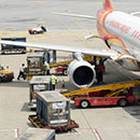
Following the loss of two thirds of passenger bellyhold cargo capacity in recent weeks, freighters are now providing 75% of air cargo capacity on all major global trade lanes compared with less than 50% before the coronavirus crisis, according to forwarder Agility’s latest air freight update on the impact of COVID-19 published today, causing average air freight prices to surge.
Quoting data from analysts Seabury, it noted that global air freight capacity overall is down 22% versus last year, and additional declines are expected. On a trade lane level, there is no longer any significant difference between capacity in or out of Asia and capacity in other regions while a general trend is that belly capacity is declining and freighter capacity is rising.
“Global belly capacity is 35% of what it was in January and still falling because of air travel restrictions and closed borders. Increases in freighter capacity are not sufficient to offset the loss of belly capacity. The current decline in belly capacity is equivalent to capacity of 400 Boeing 747-8 freighters a day.”
It said belly capacity declines last week were sharpest in Asia and the Middle East. But lanes that traditionally rely most on belly capacity - Transatlantic (Europe-US) and intra-Asia have seen the sharpest declines in overall capacity.
Agility’s update underlined that freighters now account for 75% of capacity “along all trade lanes”, adding: “Freighter capacity on Europe-US lanes has doubled since the imposition of the latest US travel restrictions and reached 80% of air cargo capacity on those routes last week. Nearly all major international airports are seeing increases in freighter capacity.”
On Europe-US routes, the main features of the current market are capacity shortages and “considerable” increases to spot price rates. Space is nonetheless available but “with constraints” while there are “significant capacity constraints” and a “surge” in rates on Europe-China routes.
Turning to the Asia-Pacific region, the update said that wide-body capacity decreases have taken place across all routes.
“All major Asian airports are showing declines in cargo capacity. Hong Kong, Shanghai and Beijing show the largest declines in cargo capacity.
Agility added that there is “continued pressure on China outbound and inbound, but with some signs of recovery: Outbound air freight capacity is under tremendous pressure among all mainland China export markets as production resumes and passenger flight cancellations are sustained. A trend of ocean-to-air conversions exacerbates pressure on capacity outbound China. However, more freighters are entering the market.”
It continued: “Inbound capacity constraints from Europe, the Americas and the Middle East continue as all regions have reduced passenger operations to China.”
The update also highlighted an “unprecedented rate surge on intra-Asian lanes” due to massive capacity reduction resulting from passenger flight and freighter cancellations.
“Air freight rates on intra-Asia lanes are extremely high, volatile and have been increasing rapidly, which are in turn constraining the long-haul export capacity to both Europe and the US.”
Intra-Asia lanes are experiencing heavy congestion from South China, but the export market from Hong Kong to Europe and US is picking up gradually.
“We have seen a sharp increase in rates to both Europe and the US, triggered by new entry restrictions. Charter rates have surged.”
Source:lloydsloadinglist
The opinions expressed herein are the author's and not necessarily those of The OLO News.
Quality Companies